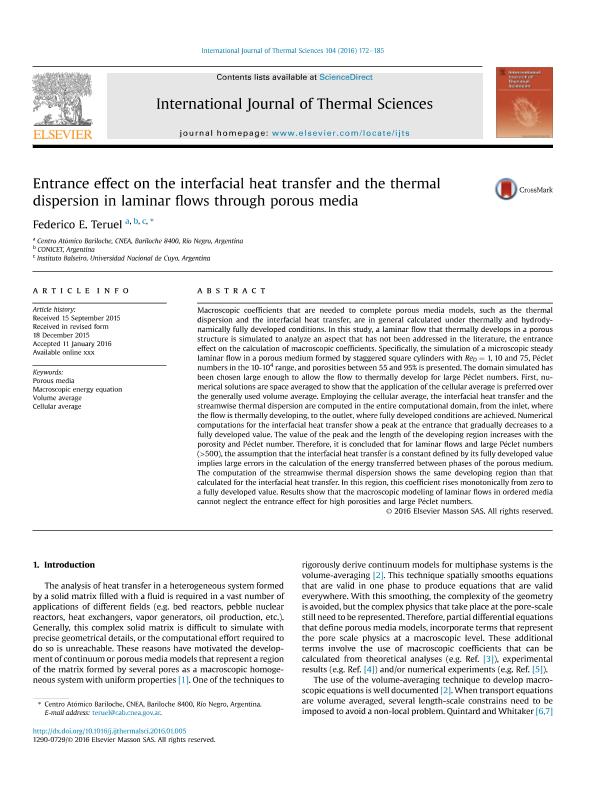Mostrar el registro sencillo del ítem
dc.contributor.author
Teruel, Federico Eduardo

dc.date.available
2018-09-17T13:48:04Z
dc.date.issued
2016-06
dc.identifier.citation
Teruel, Federico Eduardo; Entrance effect on the interfacial heat transfer and the thermal dispersion in laminar flows through porous media; Elsevier France-editions Scientifiques Medicales Elsevier; International Journal Of Thermal Sciences; 104; 6-2016; 172-185
dc.identifier.issn
1290-0729
dc.identifier.uri
http://hdl.handle.net/11336/59835
dc.description.abstract
Macroscopic coefficients that are needed to complete porous media models, such as the thermal dispersion and the interfacial heat transfer, are in general calculated under thermally and hydrodynamically fully developed conditions. In this study, a laminar flow that thermally develops in a porous structure is simulated to analyze an aspect that has not been addressed in the literature, the entrance effect on the calculation of macroscopic coefficients. Specifically, the simulation of a microscopic steady laminar flow in a porous medium formed by staggered square cylinders with ReD = 1, 10 and 75, Péclet numbers in the 10-104 range, and porosities between 55 and 95% is presented. The domain simulated has been chosen large enough to allow the flow to thermally develop for large Péclet numbers. First, numerical solutions are space averaged to show that the application of the cellular average is preferred over the generally used volume average. Employing the cellular average, the interfacial heat transfer and the streamwise thermal dispersion are computed in the entire computational domain, from the inlet, where the flow is thermally developing, to the outlet, where fully developed conditions are achieved. Numerical computations for the interfacial heat transfer show a peak at the entrance that gradually decreases to a fully developed value. The value of the peak and the length of the developing region increases with the porosity and Péclet number. Therefore, it is concluded that for laminar flows and large Péclet numbers (>500), the assumption that the interfacial heat transfer is a constant defined by its fully developed value implies large errors in the calculation of the energy transferred between phases of the porous medium. The computation of the streamwise thermal dispersion shows the same developing region than that calculated for the interfacial heat transfer. In this region, this coefficient rises monotonically from zero to a fully developed value. Results show that the macroscopic modeling of laminar flows in ordered media cannot neglect the entrance effect for high porosities and large Péclet numbers.
dc.format
application/pdf
dc.language.iso
eng
dc.publisher
Elsevier France-editions Scientifiques Medicales Elsevier

dc.rights
info:eu-repo/semantics/openAccess
dc.rights.uri
https://creativecommons.org/licenses/by-nc-sa/2.5/ar/
dc.subject
Cellular Average
dc.subject
Macroscopic Energy Equation
dc.subject
Porous Media
dc.subject
Volume Average
dc.subject.classification
Astronomía

dc.subject.classification
Ciencias Físicas

dc.subject.classification
CIENCIAS NATURALES Y EXACTAS

dc.title
Entrance effect on the interfacial heat transfer and the thermal dispersion in laminar flows through porous media
dc.type
info:eu-repo/semantics/article
dc.type
info:ar-repo/semantics/artículo
dc.type
info:eu-repo/semantics/publishedVersion
dc.date.updated
2018-09-10T15:53:15Z
dc.journal.volume
104
dc.journal.pagination
172-185
dc.journal.pais
Francia

dc.journal.ciudad
Paris
dc.description.fil
Fil: Teruel, Federico Eduardo. Consejo Nacional de Investigaciones Científicas y Técnicas; Argentina. Comisión Nacional de Energía Atómica. Centro Atómico Bariloche; Argentina. Universidad Nacional de Cuyo; Argentina
dc.journal.title
International Journal Of Thermal Sciences

dc.relation.alternativeid
info:eu-repo/semantics/altIdentifier/doi/https://dx.doi.org/10.1016/j.ijthermalsci.2016.01.005
dc.relation.alternativeid
info:eu-repo/semantics/altIdentifier/url/https://www.sciencedirect.com/science/article/pii/S129007291530048X
Archivos asociados
